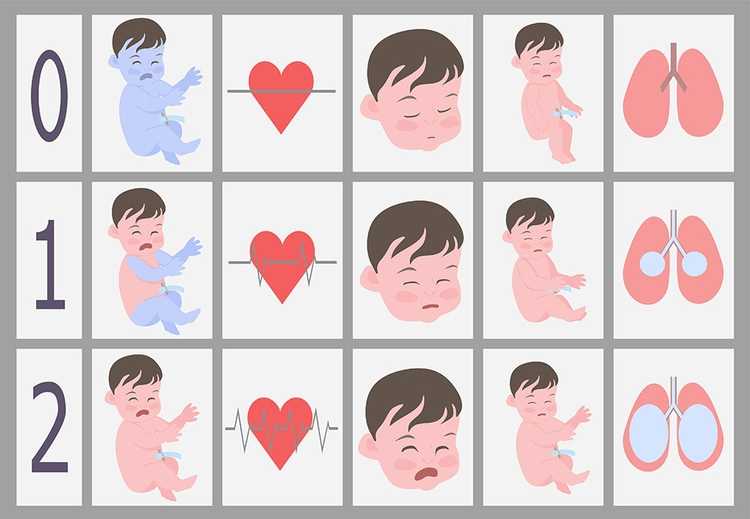
Apgar score of the newborn after birth. What exactly is it?
Childbirth is difficult not only for the mother, but also for the child. After 9 months, during which the baby was developing in her womb, the mother has to cope with a new situation, how to take care of the baby. The newborn, in turn, has to adapt to the conditions of life outside the womb - from a calm and safe environment with an optimal temperature, he gets into an environment full of stimuli with an unstable temperature, where he no longer has everything in one "package".
During postnatal adaptation, the newborn adapts to the new situation using a set of adaptation mechanisms. Using the Apgar score, the condition of the newborn is evaluated immediately after birth (in the 1st, 5th and 10th minutes). In total, a newborn can reach 10 points.
Postnatal adaptation with a normal course
In the womb, the baby's lungs are filled with fluid, and the placenta provides nutrition and blood gas exchange. As the fetus passes through the birth canal, the chest is compressed, which eliminates part of the lung fluid, after birth, the lungs expand and the baby cries. During caesarean section, the chest compression phase is missing and the cleaning of fetal lung fluid is delayed.
Taping and tying the umbilical cord in a newborn leads to an increase in systemic vascular resistance and blood pressure, a decrease in vascular resistance in the lungs, and the blood circulation gradually changes from fetal to adult - the so-called closure of the fetal shunts on the heart. The optimal course of adaptation is for most newborns born at term, only about 10% need a certain degree of assistance during postpartum adaptation to start breathing. It is the evaluation/scoring system that is used to assess the need for resuscitation of a newborn after birth.
Apgar score - what is it?
The Apgar score or Apgar score was developed in 1952 by the American anesthesiologist Virginia Apgar. It is a standardized scoring system used to assess the condition of the newborn immediately after birth. This score reveals how the baby coped with the birth and how it adapted to life outside the womb.
The condition of the newborn is evaluated in the 1st, 5th and 10th minutes after birth, while it evaluates 5 vital signs - appearance and color of the skin, heart activity, reaction to external stimuli, movement and activity of muscles, breathing. The score is evaluated from 0 to 2 points, so a newborn can achieve a total of 10 points. According to the level of the score, it is evaluated whether the newborn is healthy, whether it requires medical attention or its condition is critical and requires medical intervention. Two points are awarded if the child's health status is completely adequate, 1 point if it is partially adequate and 0 points if it is not adequate.

Apgar score criteria for newborns
When determining the Apgar score, 5 criteria are taken into account, which are evaluated based on certain aspects:
- Skin color ( Appearance ): In this case, signs of possible bluishness, which may indicate problems with blood circulation, are examined. If the newborn's skin is pink all over the body, 2 points are given, if the skin shows signs of bluing on the extremities, 1 point is given, if the entire surface of the body shows signs of bluing, 0 points are given.
- Heart activity ( P ulse): This is a criterion that examines the function of the heart. A newborn receives 2 points if his heart rate is above 100 beats. At values lower than 100/min. 1 point is given. No cardiac function is awarded 0 points.
- Reaction to external stimuli /reaction to irritation ( grimace ): 2 points are awarded for defensive movements and screams, 1 point for grimaces, and 0 points if there is no reaction to stimuli.
- Muscle tension /muscle movement and activity ( Activity ): Limb movement and activity of the newborn are monitored. Two points are awarded to a newborn who enthusiastically moves his limbs, is active. One point is given if the movement is less intense or the newborn has slightly bent limbs. For flaccid muscles, 0 points are awarded.
- Breathing : 2 points are given for regular breathing and violent crying of the newborn, 1 point for irregular breathing and 0 points if breathing is insufficient or the newborn is not breathing.

Who and when does the Apgar test?
The condition of the newborn is assessed by a neonatologist (pediatrician) or a nurse who is present at the birth. They perform the first test 1 minute after birth, the second 5 minutes and the third 10 minutes after birth. In total, he can get 10-10-10 points, usually 10 points - the highest score is used only occasionally, usually 1 point is lost by the newborn, because after birth the child often has bluish hands and feet. If in the 1st minute the score is lower, reaches 1 to 6 points, the intervention of the medical staff and the provision of help to the newborn - suctioning of the airways, tactile stimulation or circulatory support - is necessary. If the score rises to 7-10 points in the following minutes, this is a good indicator. If it does not increase, the prognosis regarding the health of the baby is not favorable.
An Apgar score of 7 to 10 corresponds to a healthy newborn, a number of 4 to 6 points means that the newborn has certain difficulties, it may only be a temporary condition, fewer points mean that medical intervention is necessary for the newborn because the basic vital functions are impaired. Low values of the Apgar score after the 1st minute do not necessarily mean that the child will have problems in the future, the opposite is also true. Babies born by caesarean section or born prematurely score lower than babies born at term on the first measurement.
When measured in the 5th and 10th minutes, 80 to 90% of children have 7 to 10 points, which means that the newborn is adapting well after birth. Values of 4 to 6 indicate that the newborn has difficulties with postpartum adaptation. A smaller number of points is a sign that the newborn has problems with vital functions and requires urgent medical attention.
A low Apgar score after the 5th minute (less than 5 points) is referred to as birth asphyxia (breathing disorder immediately after birth). A score of 0 means that the newborn shows no signs of life. If the Apgar score is low, further examinations are performed to assess the condition of the newborn, primarily blood gas examination from the umbilical cord blood sample. It is used to determine the correct supply of tissues with oxygen.

Risk groups
A lower Apgar score can be predicted in some cases. Not only newborns who were born prematurely or who had an instrumental birth (caesarean section, using a vacuum extractor or forceps) can have a problem with postpartum adaptation. The prediction of a low Apgar score is also in cases of disease during pregnancy (e.g. gestational diabetes, high blood pressure or preeclampsia), use of drugs during pregnancy and during childbirth, premature outflow of amniotic fluid, emergency conditions (premature separation of the placenta), infections, birth defects of the fetus or abnormalities during fetal monitoring (abnormal cardiotocographic recording or abnormal amnioscopy).
Apgar score - experience
The mothers revealed in the discussions that a low Apgar score does not automatically mean that the child will have problems with development. Most of the mothers confirmed that the scores were high for their little ones, usually the values were 8 to 10, but even with values of 5/6-7-7 even lower there were no problems later. As long as the Apgar score increased, no consequences appeared.
The most frequent questions - FAQ
Every parent wants to have a healthy baby, the Apgar score is one of the methods to find out the condition of the newborn immediately after birth. Although it is very helpful and reveals whether the child is fine or requires medical attention, it does not reveal how it will develop in the future. Do you want to know more about this test, or do you need to explain something further? Tell us what interests you in the comments.
Is an Apgar score of 9 enough?
What Apgar score is considered normal?
What is the lowest Apgar score?
Gallery
Pridať komentár







